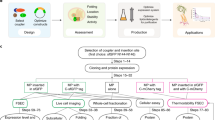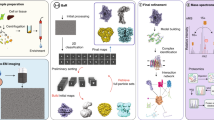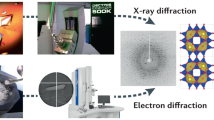Abstract
Protein crystallography is used to generate atomic resolution structures of protein molecules. These structures provide information about biological function, mechanism and interaction of a protein with substrates or effectors including DNA, RNA, cofactors or other small molecules, ions and other proteins. This technique can be applied to membrane proteins resident in the membranes of cells. To accomplish this, membrane proteins first need to be either heterologously expressed or purified from a native source. The protein has to be extracted from the lipid membrane with a mild detergent and purified to a stable, homogeneous population that may then be crystallized. Protein crystals are then used for X-ray diffraction to yield atomic resolution structures of the desired membrane protein target. Below, we present a general protocol for the growth of diffraction quality membrane protein crystals. The process of protein crystallization is highly variable, and obtaining diffraction quality crystals can require weeks to months or even years in some cases.
This is a preview of subscription content, access via your institution
Access options
Subscribe to this journal
Receive 12 print issues and online access
$259.00 per year
only $21.58 per issue
Buy this article
- Purchase on Springer Link
- Instant access to full article PDF
Prices may be subject to local taxes which are calculated during checkout






Similar content being viewed by others
References
Kendrew, J.C. et al. A three-dimensional model of the myoglobin molecule obtained by X-ray analysis. Nature 181, 662–666 (1958).
Deisenhofer, J., Epp, O., Miki, K., Huber, R. & Michel, H. Structure of the protein subunits in the photosynthetic reaction centre of Rhodopseudomonas viridis at 3Å resolution. Nature 318, 618–624 (1985).
Doyle, D.A. et al. The structure of the potassium channel: molecular basis of K+ conduction and selectivity. Science 280, 69–77 (1998).
Ostermeier, C. & Michel, H. Crystallization of membrane proteins. Curr. Opin. Struct. Biol. 7, 697–701 (1997).
Opekarova, M. & Tanner, W. Specific lipid requirements of membrane proteins—a putative bottleneck in heterologous expression. Biochim. Biophys. Acta 1610, 11–22 (2003).
Cregg, J.M., Cereghino, J.L., Shi, J. & Higgins, D.R. Recombinant protein expression in Pichia pastoris . Mol. Biotechnol. 16, 23–52 (2000).
Cereghino, J.L. & Cregg, J.M. Heterologous protein expression in the methylotrophic yeast Pichia pastoris . FEMS Microbiol. Rev. 24, 45–66 (2000).
Long, S.B., Campbell, E.B. & Mackinnon, R. Crystal structure of a mammalian voltage-dependent Shaker family K+ channel. Science 309, 897–903 (2005).
Tornroth-Horsefield, S. et al. Structural mechanism of plant aquaporin gating. Nature 439, 688–694 (2006).
Jidenko, M. et al. Crystallization of a mammalian membrane protein overexpressed in Saccharomyces cerevisiae. Proc. Natl. Acad. Sci. USA 102, 11687–11691 (2005).
Pedersen, B.P., Buch-Pedersen, M.J., Morth, J.P., Palmgren, M.G. & Nissen, P. Crystal structure of the plasma membrane proton pump. Nature 450, 1111–1114 (2007).
Jasti, J., Furukawa, H., Gonzales, E.B. & Gouaux, E. Structure of acid-sensing ion channel 1 at 1.9 Å resolution and low pH. Nature 449, 316–323 (2007).
Reeves, P.J., Callewaert, N., Contreras, R. & Khorana, H.G. Structure and function in rhodopsin: high-level expression of rhodopsin with restricted and homogeneous N-glycosylation by a tetracycline-inducible N-acetylglucosaminyltransferase I-negative HEK293S stable mammalian cell line. Proc. Natl. Acad. Sci. USA 99, 13419–13424 (2002).
Reeves, P.J., Kim, J.M. & Khorana, H.G. Structure and function in rhodopsin: a tetracycline-inducible system in stable mammalian cell lines for high-level expression of opsin mutants. Proc. Natl. Acad. Sci. USA 99, 13413–13418 (2002).
Gonen, T. et al. Lipid-protein interactions in double-layered two-dimensional AQP0 crystals. Nature 438, 633–638 (2005).
Oxenoid, K., Kim, H.J., Jacob, J., Sonnichsen, F.D. & Sanders, C.R. NMR assignments for a helical 40 kDa membrane protein. J. Am. Chem. Soc. 126, 5048–5049 (2004).
Opella, S.J. & Marassi, F.M. Structure determination of membrane proteins by NMR spectroscopy. Chem. Rev. 104, 3587–3606 (2004).
Howell, S.C., Mesleh, M.F. & Opella, S.J. NMR structure determination of a membrane protein with two transmembrane helices in micelles: MerF of the bacterial mercury detoxification system. Biochemistry 44, 5196–5206 (2005).
Tian, C. et al. Membrane protein preparation for TROSY NMR screening. Methods Enzymol. 394, 321–334 (2005).
Rigaud, J.L. & Levy, D. Reconstitution of membrane proteins into liposomes. Methods Enzymol. 372, 65–86 (2003).
Morera, F.J., Vargas, G., Gonzalez, C., Rosenmann, E. & Latorre, R. Ion-channel reconstitution. Methods Mol. Biol. 400, 571–585 (2007).
Andreoli, T.E. Planar lipid bilayer membranes. Methods Enzymol. 32, 513–539 (1974).
Bylund, D.B. & Toews, M.L. Radioligand binding methods: practical guide and tips. Am. J. Physiol. 265, L421–L429 (1993).
Bylund, D.B., Deupree, J.D. & Toews, M.L. Radioligand-binding methods for membrane preparations and intact cells. Methods Mol. Biol. 259, 1–28 (2004).
Lebowitz, J., Lewis, M.S. & Schuck, P. Modern analytical ultracentrifugation in protein science: a tutorial review. Protein Sci. 11, 2067–2079 (2002).
Hong, X., Weng, Y.X. & Li, M. Determination of the topological shape of integral membrane protein light-harvesting complex LH2 from photosynthetic bacteria in the detergent solution by small-angle X-ray scattering. Biophys. J. 86, 1082–1088 (2004).
Lipfert, J. & Doniach, S. Small-angle X-ray scattering from RNA, proteins, and protein complexes. Annu. Rev. Biophys. Biomol. Struct. 36, 307–327 (2007).
Putnam, C.D., Hammel, M., Hura, G.L. & Tainer, J.A. X-ray solution scattering (SAXS) combined with crystallography and computation: defining accurate macromolecular structures, conformations and assemblies in solution. Q Rev. Biophys. 40, 191–285 (2007).
Folta-Stogniew, E. & Williams, K.R. Determination of molecular masses of proteins in solution: implementation of an HPLC size exclusion chromatography and laser light scattering service in a core laboratory. J. Biomol. Techniques 10, 51–63 (1999).
Swords, N.A. & Wallace, B.A. Circular-dichroism analyses of membrane proteins: examination of environmental effects on bacteriorhodopsin spectra. Biochem. J. 289 (Part 1): 215–219 (1993).
Wallace, B.A., Lees, J.G., Orry, A.J., Lobley, A. & Janes, R.W. Analyses of circular dichroism spectra of membrane proteins. Protein Sci. 12, 875–884 (2003).
Fu, D., Libson, A. & Stroud, R. The structure of GlpF, a glycerol conducting channel. Novartis Found Symp. 245, 51–61; discussion 61–65, 165–168 (2002).
Savage, D.F., Egea, P.F., Robles-Colmenares, Y., O'Connell, J.D. III & Stroud, R.M. Architecture and selectivity in aquaporins: 2.5 a X-ray structure of aquaporin Z. PLoS Biol. 1, E72 (2003).
Harries, W.E., Akhavan, D., Miercke, L.J., Khademi, S. & Stroud, R.M. The channel architecture of aquaporin 0 at a 2.2-A resolution. Proc. Natl. Acad. Sci. USA 101, 14045–14050 (2004).
Khademi, S. et al. Mechanism of ammonia transport by Amt/MEP/Rh: structure of AmtB at 1.35 A. Science 305, 1587–1594 (2004).
Lee, J.K. et al. Structural basis for conductance by the archaeal aquaporin AqpM at 1.68 A. Proc. Natl. Acad. Sci. USA 102, 18932–18937 (2005).
Gruswitz, F., O'Connell, J. III & Stroud, R.M. Inhibitory complex of the transmembrane ammonia channel, AmtB, and the cytosolic regulatory protein, GlnK, at 1.96 A. Proc. Natl. Acad. Sci. USA 104, 42–47 (2007).
Newby, Z.E. et al. Crystal structure of the aquaglyceroporin PfAQP from the malarial parasite Plasmodium falciparum. Nat. Struct. Mol. Biol. 15, 619–625 (2008).
Caffrey, M. Membrane protein crystallization. J. Struct. Biol. 142, 108–132 (2003).
Garavito, R.M., Markovic-Housley, Z. & Jenkins, J.A. The growth and characterization of membrane protein crystals. J. Cryst. Growth 76, 701–709 (1986).
Garavito, R.M., Picot, D. & Loll, P.J. Strategies for crystallizing membrane proteins. J. Bioenerg. Biomembr. 28, 13–27 (1996).
Iwata, S. Methods and Results in Crystallization of Membrane Proteins 355 (International University Line, La Jolla, CA, 2003).
Michel, H. Crystallization of Membrane Proteins (CRC Press, Boca Raton, FL, 1991).
Wiener, M.C. A pedestrian guide to membrane protein crystallization. Methods 34, 364–372 (2004).
Hemdan, E.S. & Porath, J. Development of immobilized metal affinity chromatography II. Interaction of amino acids with immobilized nickel iminodiacetate. J. Chromatogr. 323, 255–264 (1985).
Hemdan, E.S. & Porath, J. Development of immobilized metal affinity chromatography III. Interaction of oligopeptides with immobilized nickel iminodiacetate. J. Chromatogr. 323, 255–264 (1985).
Studier, F.W., Rosenberg, A.H., Dunn, J.J. & Dubendorff, J.W. Use of T7 RNA polymerase to direct expression of cloned genes. Methods Enzymol. 185, 60–89 (1990).
Guzman, L.M., Belin, D., Carson, M.J. & Beckwith, J. Tight regulation, modulation, and high-level expression by vectors containing the arabinose PBAD promoter. J. Bacteriol. 177, 4121–4130 (1995).
Van den Berg, B. et al. X-ray structure of a protein-conducting channel. Nature 427, 36–44 (2004).
Junge, F. et al. Large-scale production of functional membrane proteins. Cell Mol. Life Sci. (2008).
Hilf, R.J. & Dutzler, R. X-ray structure of a prokaryotic pentameric ligand-gated ion channel. Nature 452, 375–379 (2008).
Roosild, T.P. et al. NMR structure of Mistic, a membrane-integrating protein for membrane protein expression. Science 307, 1317–1321 (2005).
Makrides, S.C. Strategies for achieving high-level expression of genes in Escherichia coli . Microbiol. Rev. 60, 512–538 (1996).
Ferguson, A.D. et al. Crystal structure of inhibitor-bound human 5-lipoxygenase-activating protein. Science 317, 510–512 (2007).
Miroux, B. & Walker, J.E. Over-production of proteins in Escherichia coli: mutant hosts that allow synthesis of some membrane proteins and globular proteins at high levels. J. Mol. Biol. 260, 289–298 (1996).
Hannig, G. & Makrides, S.C. Strategies for optimizing heterologous protein expression in Escherichia coli . Trends Biotechnol. 16, 54–60 (1998).
Yeliseev, A.A., Wong, K.K., Soubias, O. & Gawrisch, K. Expression of human peripheral cannabinoid receptor for structural studies. Protein Sci. 14, 2638–2653 (2005).
Raman, P., Cherezov, V. & Caffrey, M. The membrane protein data bank. Cell Mol. Life Sci. 63, 36–51 (2006).
Newstead, S., Ferrandon, S. & Iwata, S. Rationalizing alpha-helical membrane protein crystallization. Protein Sci. 17, 466–472 (2008).
Garavito, R.M. & Ferguson-Miller, S. Detergents as tools in membrane biochemistry. J. Biol. Chem. 276, 32403–32406 (2001).
Chiu, M.L., Tsang, C., Grihalde, N. & MacWilliams, M.P. Over-expression, solubilization, and purification of G protein-coupled receptors for structural biology. Comb. Chem. High Throughput Screen 11, 439–462 (2008).
Faham, S. & Bowie, J.U. Bicelle crystallization: a new method for crystallizing membrane proteins yields a monomeric bacteriorhodopsin structure. J. Mol. Biol. 316, 1–6 (2002).
Weckstrom, K. Aqueous micellar systems in membrane protein crystallization. Partial miscibility of a nonionic surfactant in the presence of salt or polyethylene glycol. FEBS Lett. 192, 220–224 (1985).
Mohanty, A.K., Simmons, C.R. & Wiener, M.C. Inhibition of tobacco etch virus protease activity by detergents. Protein Expr. Purif. 27, 109–114 (2003).
Potschka, M. Universal calibration of gel permeation chromatography and determination of molecular shape in solution. Anal. Biochem. 162, 47–64 (1987).
Barth, H.G., Boyes, B.E. & Jackson, C. Size exclusion chromatography. Anal. Chem. 66, 595R–620R (1994).
Ricker, R.D. & Sandoval, L.A. Fast, reproducible size-exclusion chromatography of biological macromolecules. J. Chromatogr. A 743, 43–50 (1996).
Trathnigg, B. Size-exclusion chromatography of polymers. in Encyclopedia of Analytical Chemistry (ed. Meyers, R.A.) 8008–8034 (John Wiley & Sons Ltd, Chichester, 2000).
Strop, P. & Brunger, A.T. Refractive index-based determination of detergent concentration and its application to the study of membrane proteins. Protein Sci. 14, 2207–2211 (2005).
Bergfors, T.M. Protein Crystallization 306 (International University Line, La Jolla, CA, 1999).
Walter, T.S. et al. A procedure for setting up high-throughput nanolitre crystallization experiments. I. Protocol design and validation. J. Appl. Cryst. 36, 308–314 (2003).
McPherson, A. & Cudney, B. Searching for silver bullets: an alternative strategy for crystallizing macromolecules. J. Struct. Biol. 156, 387–406 (2006).
Guan, L., Smirnova, I.N., Verner, G., Nagamori, S. & Kaback, H.R. Manipulating phospholipids for crystallization of a membrane transport protein. Proc. Natl. Acad. Sci. USA 103, 1723–1726 (2006).
McFerrin, M.B. & Snell, E.H. The development and applicatioin of a method to quantify the quality of cryoprotectant solutions using standard area-detector X-ray images. J. Appl. Cryst. 35, 538–545 (2002).
Heras, B. & Martin, J.L. Post-crystallization treatments for improving diffraction quality of protein crystals. Acta Crystallogr. D Biol. Crystallogr. 61, 1173–1180 (2005).
Cohen, S.L. & Chait, B.T. Mass spectrometry as a tool for protein crystallography. Annu. Rev. Biophys. Biomol. Struct. 30, 67–85 (2001).
Hunte, C. & Michel, H. Crystallisation of membrane proteins mediated by antibody fragments. Curr. Opin. Struct. Biol. 12, 503–508 (2002).
Jiang, Y. et al. X-ray structure of a voltage-dependent K+ channel. Nature 423, 33–41 (2003).
Landau, E.M. & Rosenbusch, J.P. Lipidic cubic phases: a novel concept for the crystallization of membrane proteins. Proc. Natl. Acad. Sci. USA 93, 14532–14535 (1996).
Nollert, P. Lipidic cubic phases as matrices for membrane protein crystallization. Methods 34, 348–353 (2004).
Ng, J.D., Gavira, J.A. & Garcia-Ruiz, J.M. Protein crystallization by capillary counterdiffusion for applied crystallographic structure determination. J. Struct. Biol. 142, 218–231 (2003).
Hansen, C.L., Skordalakes, E., Berger, J.M. & Quake, S.R. A robust and scalable microfluidic metering method that allows protein crystal growth by free interface diffusion. Proc. Natl. Acad. Sci. USA 99, 16531–16536 (2002).
Hansen, C. & Quake, S.R. Microfluidics in structural biology: smaller, faster em leader better. Curr. Opin. Struct. Biol. 13, 538–544 (2003).
Hansen, C.L., Classen, S., Berger, J.M. & Quake, S.R. A microfluidic device for kinetic optimization of protein crystallization and in situ structure determination. J. Am. Chem. Soc. 128, 3142–3143 (2006).
Sambrook, J., Fritsch, E.F. & Maniatis, T. Molecular Cloning: A Laboratory Manual (Cold Spring Laboratory Press, New York, USA, 1989).
Savage, D.F., Anderson, C.L., Robles-Colmenares, Y., Newby, Z.E. & Stroud, R.M. Cell-free complements in vivo expression of the E. coli membrane proteome. Protein Sci. 16, 966–976 (2007).
McPherson, A. Current approaches to macromolecular crystallization. Eur. J. Biochem. 189, 1–23 (1990).
Acknowledgements
Research was supported by NIH grant RO1 GM24485 to R.M.S., the NIH Roadmap center grant P50 GM073210 and the Specialized Center grant of the Protein Structure Initiative U54 GM074929-01. We thank Rebecca Robbins in the Stroud laboratory and Ryan R Atkinson for helpful discussions and help in preparing the manuscript. We also thank the reviewers and editors for their helpful suggestions.
Author information
Authors and Affiliations
Corresponding author
Rights and permissions
About this article
Cite this article
Newby, Z., O'Connell, J., Gruswitz, F. et al. A general protocol for the crystallization of membrane proteins for X-ray structural investigation. Nat Protoc 4, 619–637 (2009). https://doi.org/10.1038/nprot.2009.27
Published:
Issue Date:
DOI: https://doi.org/10.1038/nprot.2009.27
This article is cited by
-
An improved fluorescent tag and its nanobodies for membrane protein expression, stability assay, and purification
Communications Biology (2020)
-
High-throughput stability screening for detergent-solubilized membrane proteins
Scientific Reports (2019)
-
DABs are inorganic carbon pumps found throughout prokaryotic phyla
Nature Microbiology (2019)
-
Single amino acid substitutions in the selectivity filter render NbXIP1;1α aquaporin water permeable
BMC Plant Biology (2017)
Comments
By submitting a comment you agree to abide by our Terms and Community Guidelines. If you find something abusive or that does not comply with our terms or guidelines please flag it as inappropriate.



